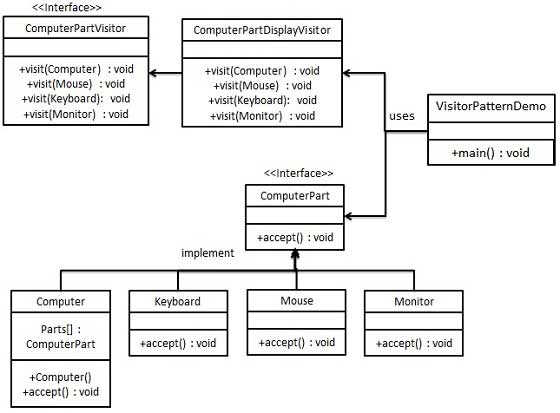我之前设想过日志功能,所有的类所有的对象都要记录日志功能,是的,所有的类,所有的对象,并且对于各个不同的类和对象要记录的内容是不一样的,但是记录日志这个功能很明显是属于某类算法,所以我就把它们都放在一个类或者类体系中,这里必须注意,我当然可以调用日志类中某个具体的方法了,但是如果我需要把这些类放在一个集合中,当成一类对象来处理的话,那么访问者模式就要发挥作用了。
In Visitor pattern, we use a visitor class which changes the executing algorithm of an element class. By this way, execution algorithm of element can vary as and when visitor varies. This pattern comes under behavior pattern category. As per the pattern, element object has to accept the visitor object so that visitor object handles the operation on the element object.
对于每个具体的类,或者是不同类体系中的对象算法是不一样的,同时这些算法属于某个类别,所以最好就放在一个类或者类体系中
Implementation
We are going to create a ComputerPart interface defining accept opearation.Keyboard, Mouse, Monitor and Computer are concrete classes implementing ComputerPart interface. We will define another interface ComputerPartVisitor which will define a visitor class operations. Computer uses concrete visitor to do corresponding action.
VisitorPatternDemo, our demo class, will use Computer and ComputerPartVisitor classes to demonstrate use of visitor pattern.

Step 1
Define an interface to represent element.
ComputerPart.java
public interface ComputerPart {
public void accept(ComputerPartVisitor computerPartVisitor);
}Step 2
Create concrete classes extending the above class.
Keyboard.java
public class Keyboard implements ComputerPart {
@Override
public void accept(ComputerPartVisitor computerPartVisitor) {
computerPartVisitor.visit(this);
}
}Monitor.java
public class Monitor implements ComputerPart {
@Override
public void accept(ComputerPartVisitor computerPartVisitor) {
computerPartVisitor.visit(this);
}
}Mouse.java
public class Mouse implements ComputerPart {
@Override
public void accept(ComputerPartVisitor computerPartVisitor) {
computerPartVisitor.visit(this);
}
}Computer.java
public class Computer implements ComputerPart {
ComputerPart[] parts;
public Computer(){
parts = new ComputerPart[] {new Mouse(), new Keyboard(), new Monitor()};
}
@Override
public void accept(ComputerPartVisitor computerPartVisitor) {
for (int i = 0; i < parts.length; i++) {
parts[i].accept(computerPartVisitor);
}
computerPartVisitor.visit(this);
}
}Step 3
Define an interface to represent visitor.
ComputerPartVisitor.java
public interface ComputerPartVisitor {
public void visit(Computer computer);
public void visit(Mouse mouse);
public void visit(Keyboard keyboard);
public void visit(Monitor monitor);
}Step 4
Create concrete visitor implementing the above class.
ComputerPartDisplayVisitor.java
public class ComputerPartDisplayVisitor implements ComputerPartVisitor {
@Override
public void visit(Computer computer) {
System.out.println("Displaying Computer.");
}
@Override
public void visit(Mouse mouse) {
System.out.println("Displaying Mouse.");
}
@Override
public void visit(Keyboard keyboard) {
System.out.println("Displaying Keyboard.");
}
@Override
public void visit(Monitor monitor) {
System.out.println("Displaying Monitor.");
}
}Step 5
Use the ComputerPartDisplayVisitor to display parts of Computer.
VisitorPatternDemo.java
public class VisitorPatternDemo {
public static void main(String[] args) {
ComputerPart computer = new Computer();
computer.accept(new ComputerPartDisplayVisitor());
}
}Step 6
Verify the output.
Displaying Mouse.
Displaying Keyboard.
Displaying Monitor.
Displaying Computer.






















 被折叠的 条评论
为什么被折叠?
被折叠的 条评论
为什么被折叠?








